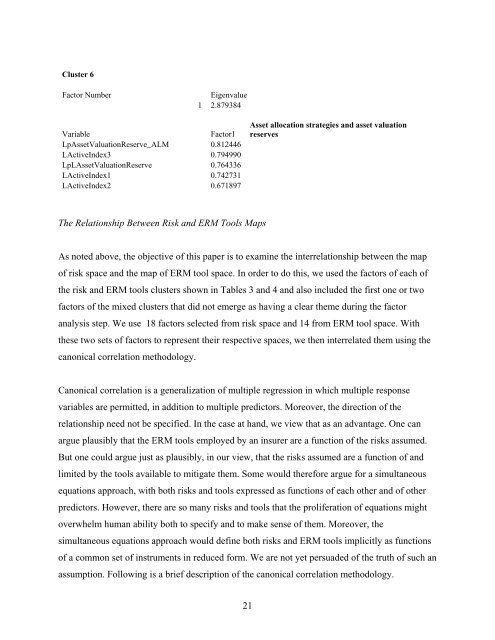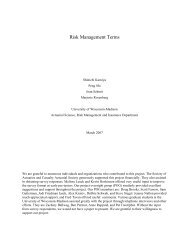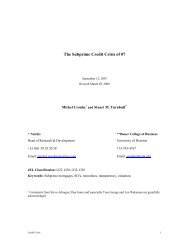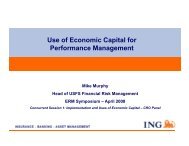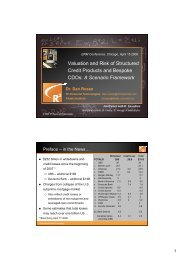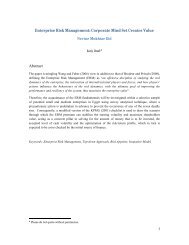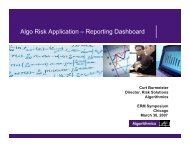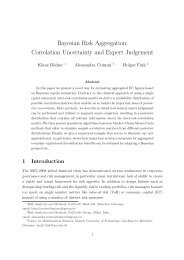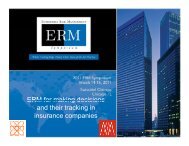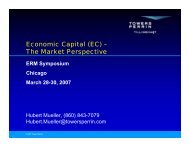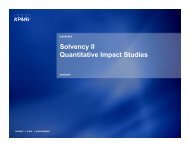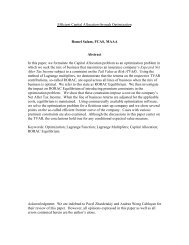An Empirical Map of Enterprise Risk Space for ... - ERM Symposium
An Empirical Map of Enterprise Risk Space for ... - ERM Symposium
An Empirical Map of Enterprise Risk Space for ... - ERM Symposium
You also want an ePaper? Increase the reach of your titles
YUMPU automatically turns print PDFs into web optimized ePapers that Google loves.
Cluster 6<br />
Factor Number Eigenvalue<br />
1 2.879384<br />
Variable Factor1<br />
LpAssetValuationReserve_ALM 0.812446<br />
LActiveIndex3 0.794990<br />
LpLAssetValuationReserve 0.764336<br />
LActiveIndex1 0.742731<br />
LActiveIndex2 0.671897<br />
The Relationship Between <strong>Risk</strong> and <strong>ERM</strong> Tools <strong>Map</strong>s<br />
21<br />
Asset allocation strategies and asset valuation<br />
reserves<br />
As noted above, the objective <strong>of</strong> this paper is to examine the interrelationship between the map<br />
<strong>of</strong> risk space and the map <strong>of</strong> <strong>ERM</strong> tool space. In order to do this, we used the factors <strong>of</strong> each <strong>of</strong><br />
the risk and <strong>ERM</strong> tools clusters shown in Tables 3 and 4 and also included the first one or two<br />
factors <strong>of</strong> the mixed clusters that did not emerge as having a clear theme during the factor<br />
analysis step. We use 18 factors selected from risk space and 14 from <strong>ERM</strong> tool space. With<br />
these two sets <strong>of</strong> factors to represent their respective spaces, we then interrelated them using the<br />
canonical correlation methodology.<br />
Canonical correlation is a generalization <strong>of</strong> multiple regression in which multiple response<br />
variables are permitted, in addition to multiple predictors. Moreover, the direction <strong>of</strong> the<br />
relationship need not be specified. In the case at hand, we view that as an advantage. One can<br />
argue plausibly that the <strong>ERM</strong> tools employed by an insurer are a function <strong>of</strong> the risks assumed.<br />
But one could argue just as plausibly, in our view, that the risks assumed are a function <strong>of</strong> and<br />
limited by the tools available to mitigate them. Some would there<strong>for</strong>e argue <strong>for</strong> a simultaneous<br />
equations approach, with both risks and tools expressed as functions <strong>of</strong> each other and <strong>of</strong> other<br />
predictors. However, there are so many risks and tools that the proliferation <strong>of</strong> equations might<br />
overwhelm human ability both to specify and to make sense <strong>of</strong> them. Moreover, the<br />
simultaneous equations approach would define both risks and <strong>ERM</strong> tools implicitly as functions<br />
<strong>of</strong> a common set <strong>of</strong> instruments in reduced <strong>for</strong>m. We are not yet persuaded <strong>of</strong> the truth <strong>of</strong> such an<br />
assumption. Following is a brief description <strong>of</strong> the canonical correlation methodology.


